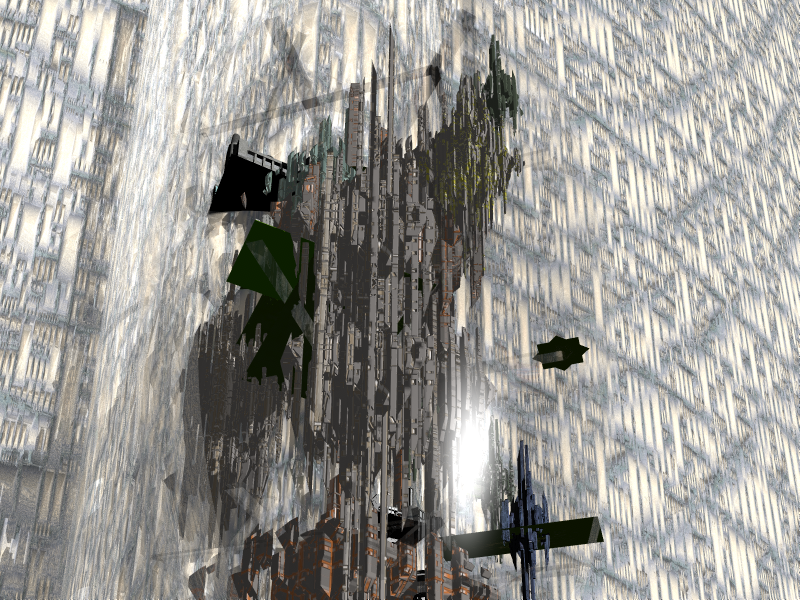
Have you ever thought what it's like, to be wanderers in the fourth dimension? Have you? To be exiles?
- Doctor Who, "An Unearthly Child"
The "human quarter" of Ex, named Namaqua by the first humans to colonize Ex many centuries ago. It was built mainly by Xanthippe and Ashizuri, as well as members of the Nao. It consists of about ten habitats and a myriad of connecting tunnels called the Labyrinth, housed within the immense supporting structure that is usually called just "the Tree" (Acer).
The Tree
The Tree extends from lower levels a few thousand kilometers down to meet with the upper geodesic spheres 500 kilometers above the highest part of Namaqua and then continues to branch into a complex known as "the bunch of bays" (although they include many habitats inhabited by unknown beings). Just above Namaqua lie several habitats belonging to the Trilos and a few Strigae habitats (the other Earth habitats are located at Nodus Antipodus, at the exact opposite side of Ex). Namaqua is supported by the Tree and buttressing arches from other parts of Ex. To the "north" (a somewhat arbitrary direction) the grand gulf yawns, an opening into Ex several hundred kilometers across. To the west lies the expanse of white cylinders belonging to the umbrae. South and east lie a complex three-dimensional structure extending into the Labyrinth underneath Namaqua, apparently consisting of a mess of small habitats, industrial sectors and labyrinthine connectors. Who or what lives there is unknown.
The ten worlds of Namaqua spiral around the Tree, with sizes ranging from 50 kilometers to over 450 kilometers. Each is a flat disc, surrounded by a cupola of diamond that also seems to regulate climate and produces a simulated sun. Due to the thickness of the atmosphere it is not obvious from the interior that it is not a planet, at least during the day. In the night the sky is filled with the grand structures above and around the world, producing a silver-golden light strong enough to read by. Near the edge it is possible to look down on other worlds and the busy activity of the Ex.
The Labyrinth
Beneath and inside the ten worlds lies the Labyrinth. The Labyrinth is a complex of tunnels, connections and devices intended to connect the worlds with each other. Some have air (and serve as pressure equalization between the worlds; they are often quite windy), others are in vacuum, and some flooded by water or coolant liquids. The entire structure is a fractal very reminiscent of a plant stem, with ever-smaller chambers and tunnels inside the walls of each other. In many places it is possible to find smaller passages branching off from main passages until they are too tiny to allow a human through. There are some people who believe Xanthippe is the tree - there is certainly enough nanoelectronics in the walls and communications nodes to hold an entire mainliner civilization, and if the Tree itself is the real body of Xanthippe it would explain just why it is so good at guessing the needs of its inhabitants.
There are fast maglev shuttles running between most of the worlds and the "elevator shaft", the immense hollow core of the main Tree trunk where the Aescul strigae run a shuttle service up to the bays.
Inside the Labyrinth there are many smaller settlements. Some are cozy microenvironments and others little more than emergency squatter camps. Here live disparates, renegades and various isolationists who don't want to join the greater Namqua society. Travel through some regions can be quite dangerous. Other parts are inhabited by strange beings. Some are drones sent exploring by various groups - some human, some not. Others are strange entities that may be escaped animals, renegade robots, living advertisements or even fashion statements from long-lost civilizations. There are constant rumors of fabulous treasures and threats in the deep labyrinth.
The Ten Worlds of Namaqua
Inculta Maxima (World 1)
Terrestrial habitat, consisting solely of desert. Many Strigae ruins dot the landscape; their origin remains unclear. It is the largest and lowest habitat of Namaqua, with exits into other parts of Ex. Although inhospitable its many mysteries have attracted many disparates, loners and explorers seeking isolation or wealth.
Ujgarek (World 2)
A habitat of steppes and arid plateaus. Inhabited by the primitive Karetn, and generally isolated. The fauna involves giant elephant shrews, used by the Karetn as food and popular as pets elsewhere in Namaqua.
Guntatoukai (World 3)
The main Shoukakegawa world. Mainly marine and tropical, dominated by extensive archipelagos connected by diamond bridges or tunnels, it seems to have been used by trilos until a few centuries earlier. The megafauna includes the Megalodon shark and several other extinct marine animals.
The main city is Gangkoudai, located on an island/peninsula linked with the exits to the labyrinth. Here lies the central offices of the major clans, important industries and the various hotels for visitors.
Near the western edge of Guntatoukai lies Dao, a mountainous island inhabited by a colony of Strigae that has been trading with Shoukakegawa since their arrival. Underneath Dao (which is actually an arcology structure) lies a major Trilo habitat.
Laxitas Traba Oriens
The hollow habitats inside the giant Eastern Beam. The Eastern Beam continues east and downwards, supporting the Tree at the level of Arx Tarautas. The habitats consist of a series of ten spherical chambers tens of kilometers large. Their floors are hilly or alpine regions with increasing levels of gravity as the beam descends. Most of the Lamplandae inhabitants live in airborne cities dominated by the Belkazanthe.
 Arx Tarautas (World
4)
Arx Tarautas (World
4)
The main habitat of Nova Roma Concordia. A fairly small habitat located on the north face of the Tree. Originally just an empty shell, the Republica Aquincorum brought down one of their orbiting city-ships and locked it onto the tree-face. They extended supporting framework across the shell, filling it with a wildly vertical city of skyscrapers, waterfalls and elevators.
Of special note is the Park of the Heroes, a monumental park commemorating the people killed in the Great War and often used for official pronouncements and ceremonies. It is suspended nearly a kilometer out in the air, reachable along a wide transparent diamond avenue. Two kilometers below lies the Senate Palace, with a similarly dramatic view of the world outside Namaqua.
Vertumnus (World 5)
A minor habitat used for farming. It is located near Arx Tarautas and has a pleasant Mediterranean climate. Originally settled by the Lamplandae, but they were driven out during the unification conflict. Today it is the main source of fruits and vegetables in Arx Tarautas and nearby habitats.
Urgunalla (World 6)
A misty tropical habitat with ecology from the Eocene. Populated by a mixed population of Lamplandae, disparates and some small Trilo cultures.
Tarilla Nami (World 7)
A Devonian landscape of hills covered by low plants, rivers filled by shelled fishes and tetrapods crawling around the lakes. Inhabited mainly by N'Modugno and Trilos.
Zhenpubu
Cylindric shaft inside the Tree, approximately two kilometers high and 500 meters across. It is dominated by an enormous freely falling mass of water (part of the Namaqua hydrological cycle) in the center, producing constant strong winds. A number of diamond bridges across the shaft cause secondary waterfalls and falling mists nurturing a complex temperate ecology on the walls. Zhenpubu was settled by the UJKH survivors, who built a hanging city along the walls.
Aquilo (World 8)
"Windy", a mostly mountainous recreation of northern Scandinavia. Sparsely populated, although mammoth hunting and Fejak (giant arctic marsupials) riding are popular sports for visitors.
Gog-Owza (World 9)
The main Lamplandae habitat, a formerly a temperate ecosystem from around 100 million years in the future. After the conflicts between the Lamplandae the ecology has become largely artificial, dominated by wild biotechnological buildings, diamond corals and a ubiquitous species of extremely hardy and flexible moss that seems able to design tailored nanodevices to protect itself and break down nearly any substrate to provide nutrients.
Gog-Owza is known as the land of the harps due to the ultrastrong carbon fibers extending here and there from the ground through the dome up to the branches of the Tree; in the wind they shiver and produce eerie sounds. Their origin and purpose is unknown.
Politically Gog-Owza is divided into several independent regions, run by various governments. The central authority is the Komed, a board of uploaded warrior-doctors controlling access to the Consensus chambers and the various nanoimmune protocols. Different factions are constantly jockeying for position and favors with the Komed, often dragging outside interest into the local issues. Nova Roma Concordia has been trying to get the Komed to support the NRC, but support has been erratic.
Insula Draconis / Gabal Aswad (World 10)
Habitat with a cretaceous ecology including dinosaurs. It is dominated by an enormous dark mountain in the middle of the habitat cupola, surrounded by hilly or mountainous terrain to an encircling lake/sea. Sparsely populated with an economy mainly based on tourism and exotic meats. The main inhabitants are the Arabic-descended culture in Wadi al Taiz that arrived from a fairly recent timeline where the Caliphate conquered much of the west and phasing was discovered in 2200's. The Taizim are technologically not very advanced, belonging to a somewhat heretic sect of techno-Muslims believing Ex Tempore to be the "second Kabah" they have to guard.
The Virtual Nations
Several posthuman cultures have appeared in Ex Tempore, but they have so little in common with the low tech embodied humans that they cannot be said to be a part of Namaqua society. Still, they are somewhat more accessible than many other alien cultures, so plenty of humans are spending much effort in communicating with them through the virtuality. Some of the most well known virtual nations are the Gohonda (loosely allied with Ashizuri, apparently fond of games and timeline recreations), the Modular Reign (somewhat anti-Homo sapiens and pro Lamplandae), the RTUI Complex, Bia Map and Hogtal-Polo (apparently in conflict with the Nao on some obscure issue).
Many of the virtual nations are located inside the Ex information structure, with no specific physical location. Some have offices or physical residences within the Labyrinth or among the branches, most notably the Bia Map.
The orbiting cities
Ex has two main bands of orbiting structures: the "blue band" that seems to be some kind of large-scale cooling or stabilization system, and the "junk band", a band filled with parked timeships, orbital habitats and stuff new arrivals brought with them. Here lie a few of the Lamplandae and Republic cities of note, including the huge Magellanese colony ship.
Nodus Antipodus
Another set of Earth habitats, at the other side of Ex. They are sparsely populated by humans but house major Strigae and Trilo settlements. Their main economic importance for the inhabitants of Namaqua is their biological diversity (collected from many long-range timelines including a few very far future versions of the Earth) which can be used in biotechnology.
Although many groups have plans for settling the Nodus, they have been resisted by the resident "god" (usually called the antipodean). The Antipodean appears to be a counterpart/consort of Xantiphe, but with noticeable human elements. According to Lamplandae stories some of the earliest humans in Ex merged with Xantiphe to form the Antipodean, and it sometimes recruits new parts of itself.